This website uses cookies so that we can provide you with the best user experience possible. Cookie information is stored in your browser and performs functions such as recognising you when you return to our website and helping our team to understand which sections of the website you find most interesting and useful.


ITEMLIST
Products Infomation
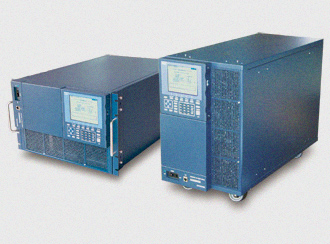
The popular analyzing AC power supply AA/X series is equipped with a LAN function as standard, making it even easier to use.
The functions necessary for power supply environment testing, such as arbitrary waveform generation function, program operation, and measurement functions comparable to power analyzers, are condensed into this one unit.
AC Power Supply AA/X2 Series
Maker:
TAKASAGO LTD.
Overview
Program output, arbitrary waveform creation function
- Emulation test of power supply environment is possible with program output and arbitrary waveform creation function by application software.
Measurement capabilities comparable to power analyzers
- Abundant measurements comparable to power analyzers (power analyzer function, harmonic analyzer function, waveform display by application software, inrush current measurement).
Single-phase high-capacity, multi-phase system realization possible
- Maximum single-phase 20kVA and three-phase 60kVA systems possible with expansion power supply units and polyphase power supply units.
Harmonic superposition function by application software
- Integer harmonics from 2 to 50 can be superimposed.
LAN port standard equipment
- LAN is equipped as standard, and complicated waveform editing, control, and measurement can be performed with an external PC by using the attached dedicated application software.
Optional variable constant current (CC) on AC power supply
- Constant current operation can be set at an arbitrary current for the superconducting coil, electrolyte, heater, fuse breaker, etc.
Application
For testing loads with large input current fluctuations such as copiersHighly stable output with AVR function
|
For measuring the inrush current of various power supply devices such as switching power suppliesCapable of measuring peak current
|
For power supply abnormality simulation of DC voltage input equipment such as communication equipment, aviation/railway equipment, ship-mounted equipment, and automobile-related equipmentSupports reliability tests for DC input devices
|
Reproducing the power supply environment in the field in the laboratoryWaveform reproduction by amplifier mode
|
For shipping inspection of lighting equipment such as fluorescent lampsHarmonic current can be measuredSimple measurement of harmonics (voltage, current) from the 2nd to 50th order is possible as well as voltage fluctuation test. In addition to normal voltage and current rms values (V or A), harmonic measurement results can also be displayed as a percentage of the fundamental wave, making it ideal for shipping inspections of lighting equipment. |
For surge resistance tests and destructive tests of electrical and electronic parts, etc.Superposition of surge voltage by pulse injection
|
For testing motors, etc.Various output sweep functions
|
For fuse melting tests and breaker testsCan be used as a constant current power supply
|
For harmonic immunity testing of electrical and electronic equipmentHarmonic superposition by arbitrary waveform creation function. Inter-harmonic superimposition by sub-synthesizer
|
Function
Program output and arbitrary waveform creation function support power environment test
● Various program output functions and arbitrary waveform creation functions (on dedicated application software) are provided as standard equipment for reliability tests in AC power environments . AA/X2 is useful for departments that require simulation of abnormal power supply environments, such as R&D and quality assurance. Arbitrary waveforms can be easily edited using dedicated application software on a personal computer, and up to 24 created waveforms can be saved in the internal memory. Similarly, in the case of program output, you can easily perform sudden output changes, sweep output, etc. simply by entering numerical values in the list of parameters such as voltage, frequency, waveform, etc. displayed on the controller screen.
 |
 |
 |
 |
| Relatively long voltage drop (instantaneous sag) | Relatively long voltage rise | Relatively long blackouts (instantaneous blackouts) | V/F sweep |
 |
 |
 |
 |
| Momentary voltage drop | instantaneous voltage rise | spiky pulse | Momentary blackout |
 |
 |
 |
 |
| Sequence output | Sudden phase change | Waveform with superimposed intermediate harmonics | flicker |
 |
 |
····other | |
| DC superposition | positive and negative pulse |
For power supply abnormality simulation reproduction tests of DC voltage input devices such as DC power supply systems such as communication equipment and equipment related to aircraft, railroads, ships, and automobiles.
●Reliability test of DC input equipment
AA/X2, DC output can supply the rated current, and it is possible to combine DC output with various functions such as program output. This makes it ideal for emulating (simulating with actual power waveforms) abnormalities in the power supply lines of devices such as DC/DC converters that use DC voltage as input. Various ripple superimposition tests can be performed by using DC offset + AC output (+ program output). Also, by using the program output (+arbitrary waveform function), in addition to normal sudden change (instantaneous power failure) tests, it is possible to output short-term sudden changes including slopes of several hundred microseconds. *The desired waveform may not be obtained depending on the type of load.
 |
 |
 |
 |
| Ripple voltage superposition with interval | Ripple voltage superposition (voltage sweep) |
Ripple voltage superposition (frequency sweep) |
Short-term slope sudden change (μSec) |
 |
 |
 |
····other |
| Short time slope sudden change (mSec) |
Voltage rise, voltage drop (with slope) |
DC sequence output |
For testing motors, etc.
●Various output sweep functions
In addition to the output sweep function by the program function, a soft start/stop function that changes the output voltage in a slope shape when the output is turned on and off, and a transient function that reaches the set value in a slope shape at a certain rate of change like a volume when changing the voltage setting are available. By using this function, it is possible to test the operation of motors, transformers, superconducting coils, etc. against changes in voltage and current. The transient function is also effective when changing the frequency setting. (Frequency sweep is performed up to the set frequency.) In addition, by using the output sweep function of the program function, voltage and frequency can be swept simultaneously, enabling testing of inverter motors, etc.
 |
 |
 |
 |
| Soft start/stop | V/F sweep | ||
| Digital control enables smooth start-stop without notches, sparks, intermittent fluctuations, etc. caused by mechanical mechanisms such as conventional rheostats (rheostats, variable resistors, starting resistors) for inrush current protection. The variable transition is smooth and accurate, and the rising phase and rising time, falling time and falling phase can be set individually to limit sudden voltage changes when the output is turned ON/OFF. By controlling ON/OFF in a trapezoidal shape and setting angles such as the start angle to 0 degrees, it is possible to suppress surge voltage due to inrush current and back electromotive force simply by setting ON/OFF to zero cross. | It is possible to test motors by combining the voltage (V) sweep function for preventing inrush current and the frequency sweep (F) function for slip suppression. | ||
change the waveform
● Sudden change in output
| The three elements of voltage, waveform, and phase can be changed abruptly to different values for a specified time. The timing of the sudden change can be specified by the phase angle, and the duration (event time) can be specified from 0.1 ms to 65 seconds and cycle with a resolution of 0.5 cycles. Sudden voltage changes can be used for power supply interruption/sag tests, and sudden phase changes can be used for system voltage phase sudden change tests for grid-connected inverters, etc. |  |
● Output sweep
| Simultaneous sweep of voltage and frequency is possible. Up to 100 combinations of sweep time, voltage, and frequency can be set, and output sweep can be performed in the shape of a line function connecting each point. The voltage sweep is convenient for power supply voltage fluctuation testing, and the voltage/frequency simultaneous sweep is useful for testing variable speed motors. Especially for motor testing, sweeps including torque boost at low rpm and mechanical resonance point skipping are possible. |  |
●Sequence output
| Voltage, frequency, and waveform can be changed sequentially. Each element combination can be written to 100 addresses, and the retention time can be set for each address. Therefore, it is possible to output envelopes with complex change patterns and steep rises and long slopes. This makes it ideal for transient voltage fluctuation and transient frequency fluctuation immunity tests. In addition, it is convenient for variation testing on the product inspection line because step feed can be performed using the controller key or an external trigger signal. |  |
make a waveform
● Arbitrary waveform creation
Arbitrary waveforms can be created with simple operations using a mouse on a PC. Waveform editing is performed using bow string editing and point data editing. Bow string editing automatically generates a polygonal line that connects two fixed left and right points on the waveform and an arbitrary point placed between them. It is also possible to perform arithmetic processing such as addition and multiplication in the specified range. Complex waveforms can be created by repeating this operation. In point data editing, you can directly specify the XY coordinates on the waveform for more detailed editing. This method is useful when you want to add spike-like unevenness to the waveform.
●Harmonic superimposition Integer harmonics
from the 2nd to 50th order can be superimposed. All you have to do is enter the harmonic level and phase angle in the list on the dedicated application software on your computer, and the distorted waveform will be automatically generated. This function can be used for harmonic immunity testing.
●
Creates a waveform that clips the positive and negative peaks of the crest factor control sine wave. At this time, the amplitude is corrected so that the effective value does not change, and a waveform with an arbitrary crest factor (crest factor) is generated. The crest factor can be set from 1.10 to 1.41, which is useful for simulating power line waveforms distorted by the input current of electronic equipment.
measure
●Electric power analyzer function
Equipped with a wide range of measurement functions that allow measurement of various tests using only the power supply. It is possible to measure not only voltage and current rms values, ± peak values, DC (average values), but also crest factors and distortion factors. Power measurement can measure not only active power, but also apparent power, reactive power, and power factor. Line voltage and total power can also be measured in three-phase system configurations. In addition, you can freely select and display up to 12 items to be displayed.
●Harmonic analyzer function
Voltage and current harmonics (spectrum) can be measured. Harmonics are processed at high speed by FFT calculation by DSP, so real-time display of measured values is possible. The RMS value and phase angle of harmonics up to the 50th order can be displayed on the LCD screen as a numerical list (V, A, or %), making it suitable for measuring harmonic current emissions.
●Inrush current measurement
By combining the peak current hold function and the output ON phase setting function, the inrush current of the device can be measured as a numerical value.
output
● Accurate output frequency
DDS (direct digital synthesizer) provides a wide range of accurate output frequencies. Frequency hopping by phase continuity is possible in sudden frequency change operation. The setting resolution is the output frequency of 0.01Hz.
● Digital AVR
compensates for load line voltage drops at the sensing end and supplies accurate voltage. Compensation operation is executed every cycle by digital feedback by DSP. Feedback acts to stabilize the rms value. In addition, calculation and correction are performed at high speed, so there is no voltage step like the conventional digital AVR.
●Offset voltage superimposition
DC offset voltage can be superimposed on AC voltage and output. Therefore, ripple superimposition tests can be performed. In addition, the program function can be used only for the AC part while superimposing the offset voltage.
●DC output possible
DC voltage output up to ±400V is possible, so it is possible to test DC/DC converters and in-vehicle equipment. Of course you can also use the program function. Output of 18A at Lo range rated output (±140V) and 9A at Hi range rated output (±280V) is possible.
●Soft start/stop function
It is possible to turn on and off the output voltage at the specified phase when the output is turned on and off. In addition, the time from when the output is turned ON until the output voltage reaches the set value (ON SLOPE), and the time from when the output voltage reaches 0 V until the output turns OFF (OFFSLOPE) can be set from 0 (50 μs or less) to 10 seconds in 10ms increments. This function is ideal for applications such as driving characteristic tests of motors, etc., where a slow rising voltage application is required, or where the coil excitation current is gradually increased.
●Pulse voltage superimposition
Pulse surge voltage can be superimposed on AC voltage. The application phase and number of times (number of cycles) can be set.
●Power amplifier operation
It can be operated as a power amplifier by inputting an analog voltage from an external signal source. Since the signal input terminal and output terminal are insulated, either side of the output line can be grounded safely.
Communication function
| A LAN communication port is provided as standard equipment. Easy operation on a personal computer and various settings can be made with the dedicated application software (included as standard). In addition to remote monitoring and control over the network, data can be saved and updated. | 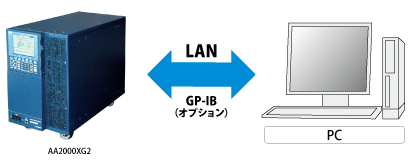 |



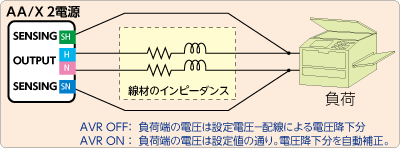 By using a digital AVR (digitally controlled automatic voltage correction function), it is possible to minimize the voltage drop in the wiring to the load. By using this function, it is possible to supply a stable voltage even to loads with large fluctuations in input current, such as copiers and electromagnetic cookers. Since the correction operation is performed by high-speed digital processing by DSP, there is no voltage step like the conventional digital AVR. Also, even if the wiring to the load is long, problems such as oscillation do not occur.
By using a digital AVR (digitally controlled automatic voltage correction function), it is possible to minimize the voltage drop in the wiring to the load. By using this function, it is possible to supply a stable voltage even to loads with large fluctuations in input current, such as copiers and electromagnetic cookers. Since the correction operation is performed by high-speed digital processing by DSP, there is no voltage step like the conventional digital AVR. Also, even if the wiring to the load is long, problems such as oscillation do not occur.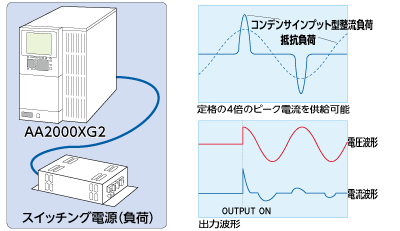 By combining the output ON/OFF phase setting and the peak hold function of the measurement mode, you can easily measure the inrush current of power supply equipment, etc. In addition, it is possible to supply and measure a peak current four times the rated current (rms value) for a load with a capacitor input type rectifier circuit.
By combining the output ON/OFF phase setting and the peak hold function of the measurement mode, you can easily measure the inrush current of power supply equipment, etc. In addition, it is possible to supply and measure a peak current four times the rated current (rms value) for a load with a capacitor input type rectifier circuit.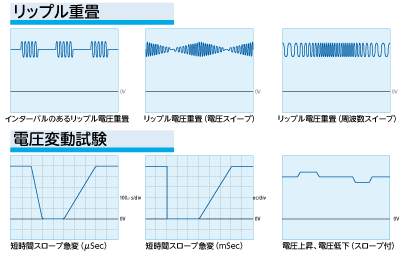 Not only can AA/X2 and DC output supply the rated current, but it is also possible to combine DC output with various functions such as program output. Therefore, it is ideal for simulating abnormalities in the power supply line of a device such as a DC/DC converter that receives a DC voltage. Various ripple superposition tests can be performed by using DC offset + AC output (+ program output). In addition, by using the program output (+arbitrary waveform function), in addition to normal sudden change (instantaneous power failure) tests, it is possible to output short-term sudden changes including slopes of several hundred microseconds. *The desired waveform may not be obtained depending on the type of load.
Not only can AA/X2 and DC output supply the rated current, but it is also possible to combine DC output with various functions such as program output. Therefore, it is ideal for simulating abnormalities in the power supply line of a device such as a DC/DC converter that receives a DC voltage. Various ripple superposition tests can be performed by using DC offset + AC output (+ program output). In addition, by using the program output (+arbitrary waveform function), in addition to normal sudden change (instantaneous power failure) tests, it is possible to output short-term sudden changes including slopes of several hundred microseconds. *The desired waveform may not be obtained depending on the type of load. By combining the power amplifier mode of the AA/X2 with the Digital Memory Scope, you can reproduce the power supply environment of the site sampled by the Memory Scope in the laboratory. This makes it possible to investigate faults in the laboratory, even when field work is difficult. Since the AA/X2 employs a high-speed linear amplifier system, it is possible to reproduce the raw voltage waveform of the field as it is.
By combining the power amplifier mode of the AA/X2 with the Digital Memory Scope, you can reproduce the power supply environment of the site sampled by the Memory Scope in the laboratory. This makes it possible to investigate faults in the laboratory, even when field work is difficult. Since the AA/X2 employs a high-speed linear amplifier system, it is possible to reproduce the raw voltage waveform of the field as it is. Pulse-shaped surge voltage can be superimposed on the normal output voltage waveform by using the pulse injection function or the output sudden change function. This function is ideal for surge resistance tests and breakdown tests of electrical and electronic components such as varistors and rectifiers. Also, by using the arbitrary waveform creation function, it is possible to apply a spike-shaped surge voltage or to apply both positive and negative surge voltages at the same time.
Pulse-shaped surge voltage can be superimposed on the normal output voltage waveform by using the pulse injection function or the output sudden change function. This function is ideal for surge resistance tests and breakdown tests of electrical and electronic components such as varistors and rectifiers. Also, by using the arbitrary waveform creation function, it is possible to apply a spike-shaped surge voltage or to apply both positive and negative surge voltages at the same time.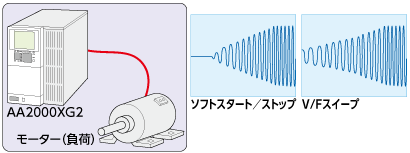 In addition to the output sweep by the program function, a soft start/stop function that changes the output voltage in a slope shape when the output is turned on and off, and a transient function that reaches the set value in a slope shape at a certain rate of change like a volume when the voltage setting is changed are provided. By using this function, it is possible to perform operation tests against changes in voltage and current of motors and coils. The transient function is also effective when changing the frequency setting. (Frequency is swept up to the set frequency.) Also, if you use the output sweep of the program function, voltage and frequency can be swept simultaneously, so you can perform optimization tests such as the starting current and starting torque of inverter motors.
In addition to the output sweep by the program function, a soft start/stop function that changes the output voltage in a slope shape when the output is turned on and off, and a transient function that reaches the set value in a slope shape at a certain rate of change like a volume when the voltage setting is changed are provided. By using this function, it is possible to perform operation tests against changes in voltage and current of motors and coils. The transient function is also effective when changing the frequency setting. (Frequency is swept up to the set frequency.) Also, if you use the output sweep of the program function, voltage and frequency can be swept simultaneously, so you can perform optimization tests such as the starting current and starting torque of inverter motors.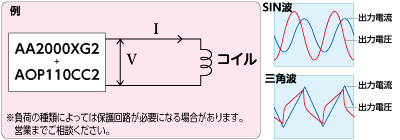 By installing the constant current option (AOP-110CC2), it can be used as a constant current power supply. Therefore, it can be used not only for superconducting coil power supplies, but also for breaker testers, fuse blowing testers, capacitor ripple current tests, etc. It can also be used as a power supply for magnetic field immunity tests.
By installing the constant current option (AOP-110CC2), it can be used as a constant current power supply. Therefore, it can be used not only for superconducting coil power supplies, but also for breaker testers, fuse blowing testers, capacitor ripple current tests, etc. It can also be used as a power supply for magnetic field immunity tests.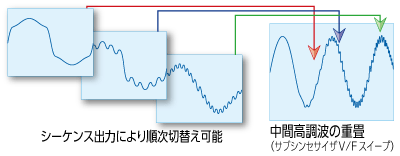 The arbitrary waveform creation function allows you to easily perform harmonic synthesis and create distorted waveforms. Also, by using the sequence output of the program function, the created distorted waveform can be sequentially switched and output, making it ideal for harmonic immunity testing. By installing the sub synthesizer option (AOP-090MS/AOP-100SS), it is possible to set the voltage and frequency independently from the main synthesizer of the AA/X2 main unit. This also makes it possible to perform immunity tests for intermediate harmonics (frequencies that are non-integer multiples of the fundamental wave).
The arbitrary waveform creation function allows you to easily perform harmonic synthesis and create distorted waveforms. Also, by using the sequence output of the program function, the created distorted waveform can be sequentially switched and output, making it ideal for harmonic immunity testing. By installing the sub synthesizer option (AOP-090MS/AOP-100SS), it is possible to set the voltage and frequency independently from the main synthesizer of the AA/X2 main unit. This also makes it possible to perform immunity tests for intermediate harmonics (frequencies that are non-integer multiples of the fundamental wave).


